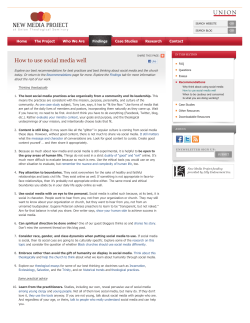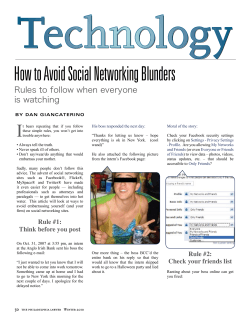
Document 249091
UNION New Media Project Home The Project Who We Are Findings Why think about using social media Case Studies Research SHARE THIS PAGE: Like Explore our recommendations regarding the general world of social media, especially if getting into it for the first time. Or return to the Recommendations page for more. Explore the Findings tab for more information about the rest of our work. 1. Social media may be new, but social relationships are not. Christians have been putting social relationships to good use for millennia. Jesus sent out his Disciples to prepare the way for his arrival in towns and villages. Paul used letters and networks of friends to carry the message across the Mediterranean world. The body of Christ is the community of followers who bear the Word of God into the world. Social media provide us new tools and new ways of thinking about those tools to share the good news of God’s love with the world. 2. Social media aren’t as scary if you think about using the tools for relationship building. Christian communities have quite a bit to say about relationships and how important it is to build and maintain good, faithful, healthy relationships. The world of social media is a little different, but fortunately it’s not as different as you may think. Mark Zuckerberg, the founder of Facebook, says in a Time Magazine article, “At its core, what we're trying to do is map out all of those trust relationships.” Writer Lev Grossman adds, “The fact that people yearned not to be liberated from their daily lives but to be more deeply embedded in them is an extraordinary insight.” 3. Churches use social media to nurture community among church members, facilitate the connections between and among members of small groups, extend pastoral care, organize events, invoke gifts among members, mobilize folks around social issues, and help people plug into the work of the church, to name a few. Our case studies are full such interesting stories. 4. Sharing the gospel in a new age is at stake. When increasing numbers of young people do not attend church but do use social media, then conveying the gospel message via new patterns of communication and in new media forms becomes essential. It is no longer optional for a church leader to ignore social media and new media trends. Consider one pastor’s experience with Facebook birthday blessings, or another’s reflection on blog comments as theological work. 5. Social media sites are like a new “public square.” If a majority of church members are on Facebook with some regularity, then why wouldn’t religious leaders also go to be present and listen to the people of God who are there. They can bring a word of God’s grace into that public square for the sake of the world. One pastor talks about it as amplifying the church’s voice in the world. Several case studies—specifically Quest Church in Seattle, Countryside Community Church in Omaha, and Community of Hope AME Church near Washington, D.C.—describe how they do this. 6. The public face of a church, ministry, or organization is increasingly marked by its online presence. More people check out organizations online than through traditional ads or the yellow pages. Some consider the online presence of a church its “front door” because so many people first discover the church through its website or other social media platforms. Having an online public presence is no longer optional, and it should be up-to-date and relevant. 7. Getting into a social media mindset does not mean just mastering a new set of communication tools to send out the same message you’ve been sending for years. It means learning how to see the world in network patterns and then sharing information and insight through those network connections. It’s about sharing with your friends, not disseminating a message out to the masses. It’s about recommending something to people you know, not just mass-producing a pitch. Information flows horizontally instead of vertically. You go deep through interconnectivity. Consider one writer’s thoughts on being “in new media” without being “of new media.” 8. Religious leaders can be excellent curators of content and builders of relationships when they see the networked patterns of communication made visible by social media and shared through those networks. Because so much information comes through social media, people are turning to their leaders to help them sort out what to read and believe. They don’t simply want a pastor to generate the message; they also want the pastor to help curate and verify (or discount) other messages. SEARCH WEBSITE GO SEARCH BLOG GO Contact IN THIS SECTION FAQ Questions Essays Recommendations Why think about using social media How to use social media well When to be cautious and concerned Is what you are doing working? Case Studies Other Resources Downloadable Resources JOIN US ENEWSLETTER SIGN UP: SUBMIT New Media Project funding provided by Lilly Endowment Inc. Lilly 9. Social media make storytelling visible in new forms and patterns. Stories and narrative continue to be very important in social media. But now a story can be told and shared and expanded, not simply in a linear fashion—beginning, middle, and end—but sideways and backwards and around the circle of friends or church members who remember different (sometimes conflicting) parts of the story. 10. Religious leaders differ on how they handle the public v. private social media questions: Should pastors “friend” their parishioners on Facebook, or keep their profile private just for family and close friends? How much personal information should pastors share with their congregations? How much do Facebook friends expect their pastors to see about themselves online? How integrated do the pastors want their lives to be online? What happens when a pastor who has many Facebook friends in a church leave that church to serve another? Social media are requiring us to see and evaluate boundaries in new ways. The women of The Young Clergy Women Project struggle with these questions in our case study. 11. Using social media for evangelism seems obvious. Social media tools provide a new way to share the Good News of Jesus Christ with a hurting world. However, when evangelism is thought of primarily as increasing numbers, then those who would use social media to advance evangelism might be disappointed. But if evangelism is understood as transformation (transforming one’s relationship with God, with others in society, with others in Christian community), then social media can offer a great advantage because of their focus on relationships. 12. Are online relationships any less real than face-to-face relationships? It depends on whom you ask. For some, the relationships they have online with their church community are life-lines because those individuals may be homebound by disability, disease, or distance. For others, the Facebook friend is secondary to the friend at church who can babysit your kids or bring you a casserole when you are ill. Christianity is an incarnational faith requiring presence and action, not just watching or speaking from afar. One of our essays explores this question of “real” v. “not real” embodied interactions from a theological and technological perspective. The New Media Project at Union Theological Seminary is a research project helping religious leaders become theologically savvy about technology. To request permission to repost this content, please contact newmedia@uts.columbia.edu. Contact New Media Project at Union Theological Seminary: Verity A. Jones 3808 N. Meridian Street Indianapolis, IN 46208 317/536-0730 newmedia@uts.columbia.edu Blog Roll Auburn Blog On Faith Beliefnet Voices Religion Dispatches Call & Response Sojourners Christianity Today Liveblog The Christian Century Blogs KineticsLive Union in Dialogue ©2012 New Media Project at Union Theological Seminary in the City of New York | Site Map Indianapolis Web Design by TBH Creative
© Copyright 2025





















![Dear [Candidate] Thank you for your willingness to stand for election](http://cdn1.abcdocz.com/store/data/000705279_1-ea0f95e6166b32e0de707cdc78468fef-250x500.png)